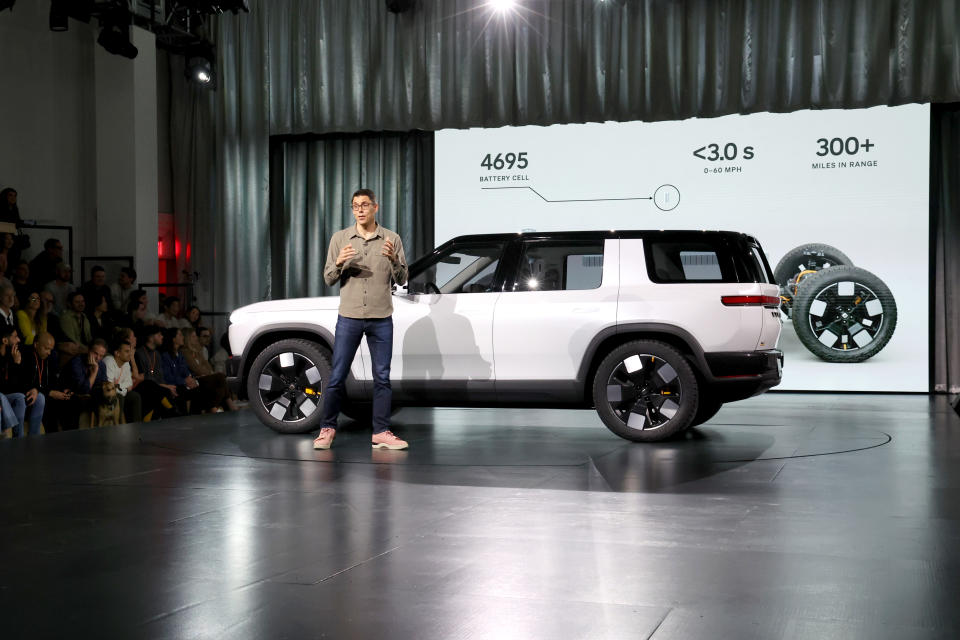Rivian reports mixed Q2 results but maintains outlook, still sees ‘modest gross profit’ by year end

Rivian announced mixed second quarter results, but the pure-play EV maker reiterated its current full-year loss and production forecasts and still sees a “modest gross profit” by the end of the year.
For the quarter, Rivian reported revenue of $1.158 billion, a slight miss compared to the $1.165 billion expected per Bloomberg consensus, though the company said it recognized $17 million from the sale of regulatory credits. Rivian posted an adjusted loss per share of $1.13, narrower than the $1.20 expected with an adjusted net income loss of $1.115 billion vs $1.194 billion expected.
Rivian reaffirmed its adjusted EBITDA loss forecast of $2.7 billion for 2024, with capital expenditure outlays hitting $1.2 billion. Rivian said it took significant steps toward profitability through the changes it made to its R1 platform and said it expects “to reach a modest gross profit” in the fourth quarter of this year.
Rivian shares were down more than 2% in after-hours trading.
“The second quarter has been a defining one for Rivian. We have demonstrated strong execution during the quarter with the plant retooling upgrade and launch of second generation R1 vehicles,” CEO RJ Scaringe said in a statement. “The changes we made to the R1 platform have allowed us to reduce material and manufacturing costs, while simultaneously improving performance and capabilities.”
Retooling upgrades to its factories had an effect on Rivian’s Q2 deliveries. Last month the company said it produced 9,612 vehicles at its Normal, Ill., assembly plant and delivered 13,790 vehicles. Both figures were down compared to the 13,980 produced and 13,588 delivered in Q1. Rivian said its Q2 production and deliveries would be “choppy” due to factory shutdowns needed for the retooling.
Rivian’s updated R1T and R1S models could be a driver of new sales, along with continued aggressive lease financing for its vehicles. Those new vehicles were available to order starting in June, the company said, with the “vast majority” of 2024 deliveries being the second-generation R1 vehicles.
This may have led Rivian to reaffirm its guidance for annual production of 57,000 total vehicles, despite the Q2 drop in vehicles produced.
Shoring up Rivian’s cash position

Rivian said it ended the second quarter with $7,867 billion in cash and cash equivalents vs. the $5.98 billion in hand at the end of Q1.
A big boost to Rivian’s cash position came in June in the form of a joint venture deal with Volkswagen, which announced plans to work with Rivian to create “next generation software-defined vehicle (SDV) architectures” to be used in both companies’ future EVs.
In exchange, Volkswagen will invest an initial $1 billion in Rivian (which is recognized in the current Q2 cash position) through an unsecured convertible note, with up to $4 billion in additional investment staged through 2026 for a total infusion of $5 billion.
“The lead program for this joint venture is expected to be our R2 platform with an expected start of production during the first half of 2026,” Rivian said in its Q2 report. “While the zonal electrical architecture and core software technology developed in the joint venture will be common across vehicle programs, R2 and other Rivian vehicles will continue to have Rivian’s highly differentiated user experience and interface and will benefit from our vertically integrated propulsion, high voltage, and autonomous driving systems.”
For Rivian, the news of fresh capital allays concerns over the company’s runway as it bridges to the release of its next-generation vehicles, the R2 and R3 mass-market SUVs.
Pras Subramanian is a reporter for Yahoo Finance covering the auto industry. You can follow him on X and on Instagram.
Read the latest financial and business news from Yahoo Finance








